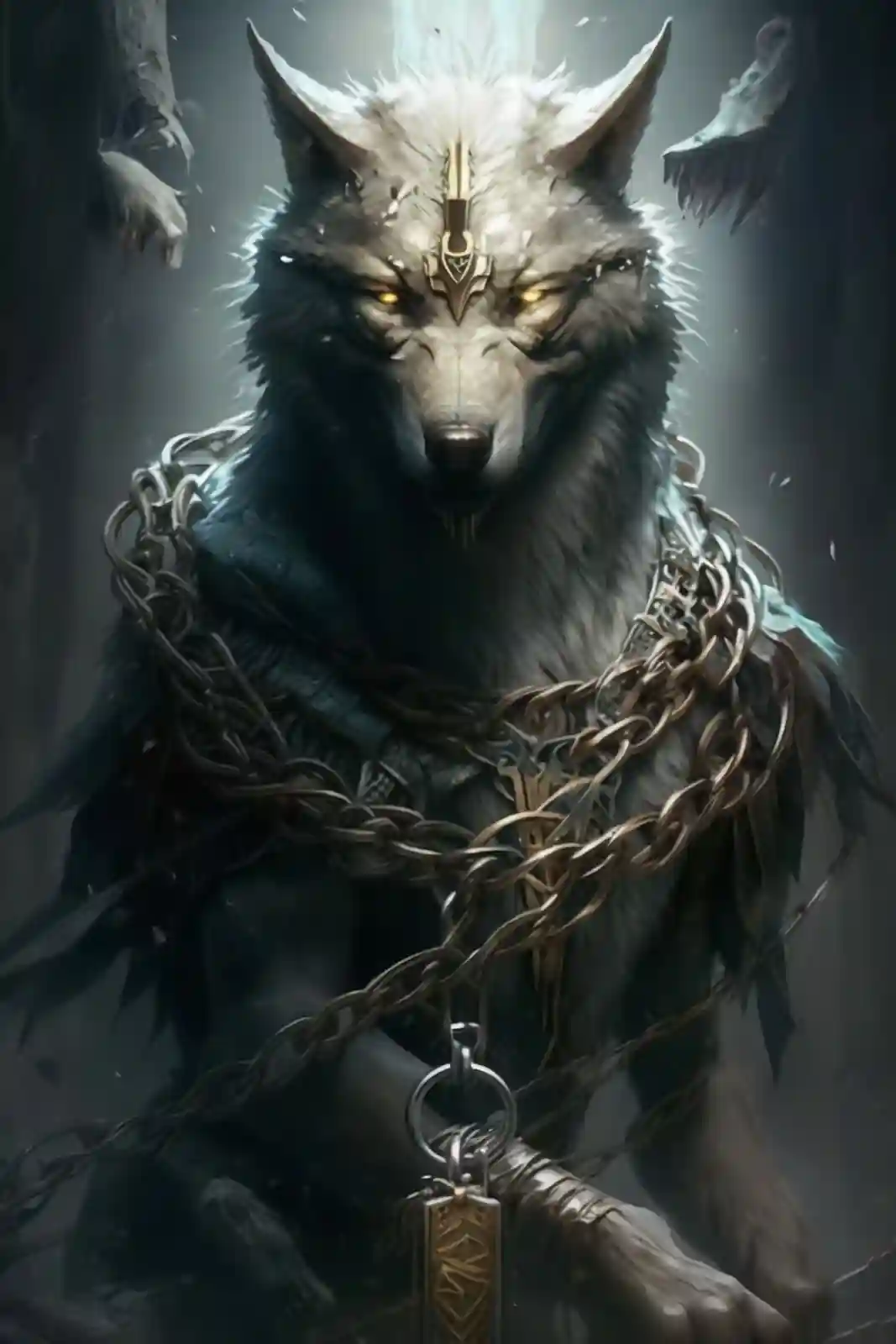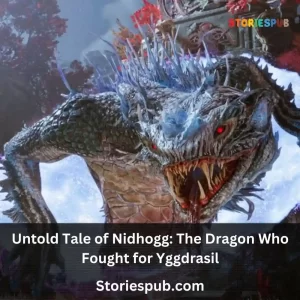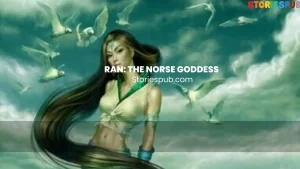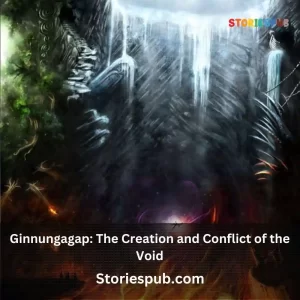Fenrir – A giant wolf who is prophesied to kill Odin during Ragnarok
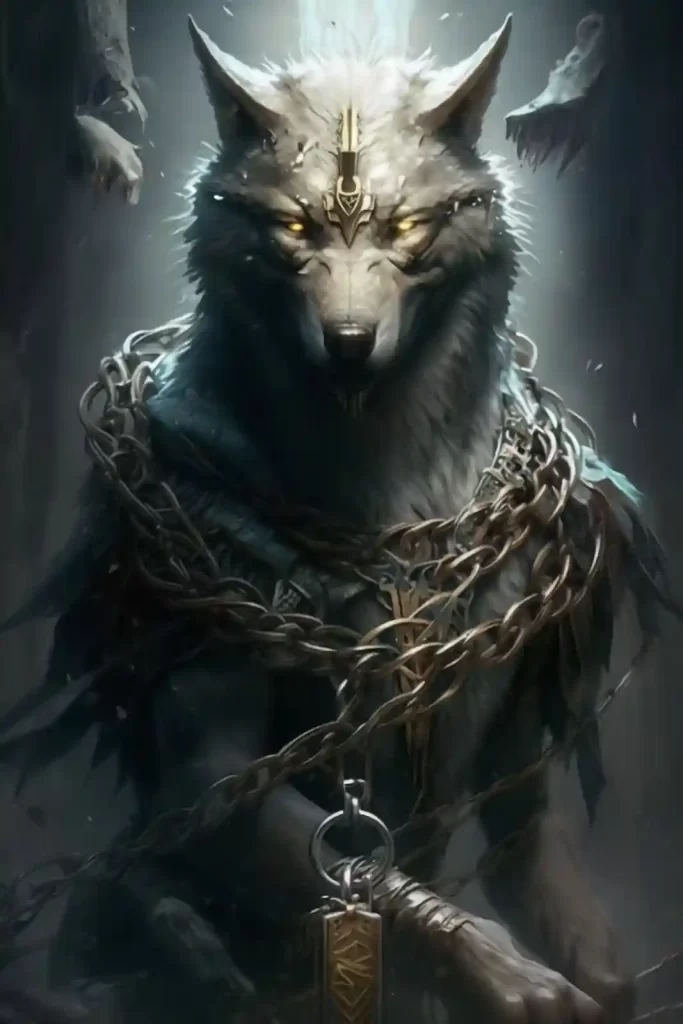
Introduction
Norse mythology is filled with many fascinating creatures and stories, but perhaps one of the most enigmatic figures in this mythos is Fenrir. Fenrir, also known as Fenrisúlfr in Old Norse, is a giant wolf and one of the central figures in Norse mythology. He is prophesied to play a pivotal role in the events leading up to Ragnarok, the end of the world.
The mythology surrounding Fenrir has been passed down through oral tradition for centuries before being transcribed into written works such as the Prose Edda and Poetic Edda. In these works, we learn that Fenrir was born to Loki, a mischievous god often associated with trickery and chaos, and Angrboda, a female jötunn or giantess.
Fenrir’s role in Norse mythology is significant because he represents chaos and destruction. He is seen as an unstoppable force that even the gods themselves cannot control.
His destiny has been predetermined since his birth when it was foretold that he would eventually play a vital role in Ragnarok. One of the most intriguing aspects of Norse mythology’s depiction of Fenrir is how his character grows throughout each story.
As he becomes more powerful and aware of his capabilities, he begins to question authority and align himself with forces that oppose the gods’ interests. This makes him an unpredictable character whose true motivations are often shrouded in mystery.
Despite his ominous reputation as a harbinger of doom for both gods and humans alike during Ragnarok, there are still many unanswered questions about this enigmatic figure. However, by examining his origins and examining how his story unfolds throughout Norse mythology’s various texts; we can gain deeper insight into this fascinating creature’s role within this mythos.
The Birth of Fenrir
Description of Fenrir’s parents, Loki and Angrboda
In Norse mythology, Fenrir is the son of two notorious figures – Loki, the trickster god, and Angrboda, a giantess. Loki is known for his cunning and mischievous behavior, while Angrboda represents chaos and destruction. Fenrir’s birth represented a union between two opposing forces in Norse mythology.
It is said that he inherited his father’s cleverness as well as his mother’s brute strength. Many believed that Fenrir would grow up to be a formidable force in the world of gods and giants.
The prophecy that foretold Fenrir’s role in Ragnarok
According to Norse mythology, there was a prophecy that foretold the downfall of the gods during an event known as Ragnarok. Among other things, it predicted that Fenrir would play a significant role in this battle.
The prophecy stated that Fenrir would break free from his bonds and join the army of giants who were fighting against the gods. In this ultimate battle between good and evil, it was foretold that Fenrir would ultimately kill Odin – one of the most powerful gods in all of Norse mythology.
How the gods tried to prevent the prophecy from coming true
The gods were understandably alarmed by this prophecy, particularly by what it meant for Odin. They knew they had to do something to prevent it from coming true.
To avoid any further trouble with their son who was growing up stronger every day, they decided to keep him under close watch until they could figure out how best to deal with him. However, despite their efforts at keeping him caged or bound by magical chains or ropes he managed to escape – each time even more enraged than before – leaving them feeling helpless against him.
Ultimately, the gods realized that they couldn’t stop the prophecy from coming true. But they did try their best to prepare for the inevitable battle with Fenrir and his allies.
Growing Up
How Fenrir grew bigger and stronger every day
As the son of Loki, a trickster god known for his shapeshifting abilities, it is no surprise that Fenrir grew rapidly and became incredibly strong. According to Norse mythology, he was born to be a formidable opponent in the upcoming battle at Ragnarok. As a result, he grew quickly and steadily, far outpacing any of his siblings.
His size and strength were feared by the gods who knew they would not be able to control him forever. Fenrir’s growth was not just physical.
He also grew in intelligence and cunning, making him even more dangerous as he aged. His sharp mind allowed him to outsmart many of the gods’ attempts to keep him contained.
His interactions with other creatures in Norse mythology, such as Odin’s ravens and Thor’s goats
As Fenrir grew larger and more powerful, he began interacting with other creatures in Norse mythology. One example is Odin’s ravens Huginn and Muninn, who flew over the earth gathering information for their master. Fenrir would often try to catch them when they flew too close to the ground or trees where he could reach them.
Another interaction was with Thor’s goats Tanngrisnir and Tanngnjóstr who pulled his chariot across the sky each day. When Thor left on one of his journeys without bringing enough food for his goats, Fenrir saw an opportunity and devoured them both.
These interactions show how Fenrir was becoming increasingly dangerous as he continued to grow in both size and intelligence. The gods knew that they could not simply ignore him or hope that he would behave himself – they had to find a way to control him before he became too powerful.
A mind too clever for its own good
Fenrir’s intelligence was both a blessing and a curse. As he grew older, he became increasingly cunning and began to see through many of the gods’ attempts to keep him under control.
He realized that they feared him and were trying to prevent his role in Ragnarok from coming true. One example of this was when the gods tried to trick Fenrir into swallowing a magical sword that would bind him forever.
Fenrir saw through their deception and refused to take the bait, knowing that he would be trapped if he did so. His cleverness also made him more vicious as he aged.
He began actively seeking out opportunities to cause harm or destruction, reveling in his power over others. This made him an even greater threat as Ragnarok approached.
A force beyond control
Despite the gods’ efforts to contain Fenrir, they ultimately failed. His growth and intelligence had made him too powerful for them to handle on their own. They knew that they needed something stronger than any weapon or magic at their disposal.
When the time came, they turned to the dwarves – master craftsmen who were known for their ability to create powerful objects imbued with magic. They commissioned a ribbon called Gleipnir, made from seemingly harmless materials such as cat’s footsteps, women’s beards, and bear sinews.
The ribbon was so strong that it could not be broken by any force known in Norse mythology – except by Fenrir himself at Ragnarok. The gods used it to bind Fenrir, but not before he had bitten off Tyr’s hand in his rage at being betrayed by his own family.
The price of power
Fenrir’s growth into a formidable opponent came at a cost – not just for those who stood against him but for his own family as well. His increasing size and intelligence led him down a path of destruction that ultimately led to his binding and eventual death at Ragnarok.
Despite his intelligence and strength, Fenrir’s fate was sealed from the moment he was born. His role in Norse mythology is a reminder that power comes at a price, and that those who seek it may ultimately find themselves bound by forces beyond their control.
The Binding of Fenrir
The gods’ fear of Fenrir and their attempts to keep him under control
The gods of Norse mythology were no strangers to danger, but they feared Fenrir more than anything else in the world. They knew that he was destined to kill Odin during Ragnarok, so they sought to keep him under control.
The first attempt was made by Tyr, who volunteered to have his hand bitten off by Fenrir as a show of good faith. This made Fenrir more trusting, but it did not prevent his inevitable destruction.
Despite their fear, the gods continued to care for and raise Fenrir like one of their own. They did everything in their power to keep him under control, but eventually realized that there was only one way to ensure that he would not kill Odin: they had to trick him into being bound.
The story of how they tricked him into being bound by a magical ribbon
Knowing that Fenrir would never willingly allow himself to be tied up or restrained in any way, the gods enlisted the help of dwarves who lived beneath the earth. The dwarves crafted a ribbon so thin it could barely be seen with the naked eye but was incredibly strong and unbreakable. When they presented this ribbon to Fenrir as proof that he could not break free from it no matter how hard he tried, he agreed to let them tie him up for fun.
Little did he know that this ribbon was actually enchanted with powerful magic that made it impossible for him ever to break free from its hold. Fenrir’s anger at being betrayed by his own family
Upon realizing what had happened, Fenrir became consumed with rage and vowed vengeance against all those who had tricked him. He pledged himself fully to the cause of chaos and destruction and bided his time until Ragnarok would come.
In this way, Fenrir’s binding became a pivotal moment in Norse mythology. It was the event that ultimately led to Ragnarok and the end of the world as we know it.
The gods’ fear and mistrust of Fenrir proved to be justified, and in their attempts to control him, they inadvertently set into motion the very events they had tried so hard to prevent. As we reflect on Fenrir’s story, we are reminded that even the mightiest gods are not immune to fear and fallibility.
In their attempts to control everything around them, they often create new problems where none existed before. And in their arrogance, they forget that sometimes there are forces beyond their control – forces like Fenrir – who will ultimately have the last laugh.
Ragnarok
Ragnarok is a Norse mythological event that marks the end of the world. It is a time when gods, giants, and monstrous creatures fight to the death. Fenrir plays an important role in this epic battle as he fulfills his prophetic destiny.
The events leading up to Ragnarok are described in great detail in Norse mythology. It begins with a series of natural disasters such as earthquakes and storms that signal the beginning of the end.
The sun and moon are devoured by wolves, plunging the world into darkness. As chaos reigns supreme, Fenrir breaks free from his bindings at last.
He had grown tired of being confined by the magic ribbon and had longed for freedom for centuries. He joins forces with his fellow monstrous creatures to take on the gods in one final attempt to destroy them all.
The Fight Against The Gods
Fenrir’s fight against Odin is one of the most dramatic moments in Norse mythology. The two foes circle each other warily, waiting for an opportunity to strike. Odin wields his famous spear Gungnir while Fenrir uses his massive jaws and claws as weapons.
Their battle rages on for hours until finally Odin realizes that he cannot defeat Fenrir alone. In a desperate attempt to turn the tide, he calls upon his son Vidar for help.
Vidar comes charging in wearing a special shoe made from all the scraps left over from making shoes throughout history – which makes it indestructible –and delivers a crushing blow to Fenrir’s jaws with his own bare hands. Despite their efforts, both Odin and Fenrir ultimately meet their doom during Ragnarok.
This is not surprising given that this was prophesied thousands of years before it even happened! In fact, some scholars believe that this cyclical nature of death and rebirth is at the heart of Norse mythology itself.
The Significance of Fenrir
Fenrir is not just a giant wolf in Norse mythology. He is also a symbol of chaos, destruction, and the inevitability of death. His story has been interpreted throughout history as a warning against the dangers of arrogance, power and greed.
The tale of Fenrir also speaks to our own human fears about death and mortality. The idea that even the gods are not immortal and will one day fall is both sobering and comforting in its own way.
Fenrir’s story is an epic one that captures the imagination with its larger-than-life characters, dramatic battles and mythic symbolism. It serves as a reminder that even the mightiest among us are subject to fate and that we should always be humble in our dealings with others.
Conclusion
After exploring the complete story of Fenrir, it is clear that he plays a significant role in Norse mythology. His birth, growing up, binding, and ultimate role in Ragnarok all contribute to his importance as a character.
While many may see him as a villainous creature that ultimately brings about the end of the world, there are deeper messages and meanings behind his story. Fenrir represents the inevitability of fate and how even the most powerful beings cannot escape their destiny.
His betrayal by his own family also speaks to the dangers of mistrust and how it can lead to disastrous consequences. In many ways, Fenrir’s story is a cautionary tale for both gods and mortals alike.
Throughout history, Fenrir’s story has been interpreted in various ways by different cultures. Some see him as a symbol of chaos and destruction while others view him as a necessary part of the cycle of life and death.
In modern times, his image has been used in popular culture such as video games and movies to represent power and strength. Despite his ominous role in Norse mythology, there is something fascinating about Fenrir that captures our imagination.
Perhaps it is his size or fearsome appearance that draws us in or maybe it is his complex backstory and prophesied fate that intrigues us. In any case, we can learn from Fenrir’s tale by recognizing the importance of destiny and trust while also acknowledging our own limitations as creatures living within an unpredictable universe.
Overall, while the end result may be unsettling for some readers–the destruction brought about by Ragnarok–there is still hope to be found through examining Fenrir’s story with fresh eyes. Just like how life continues on after every winter in Norse mythology, we too can find new beginnings even amidst endings or tragedy – so long as we keep pushing forward with resilience hope for a better tomorrow.
Hey kids, how much did you like The Fenrir – A giant wolf who is prophesied to kill Odin during Ragnarok ? Please share your view in the comment box. Also, please share this story with your friends on social media so they can also enjoy it, and for more such Norse Mythology, , please bookmark storiespub.com.
Related Post :
Fenrir FAQ
What does Fenrir look like?
The appearance of Fenrir is described as being extremely fierce and monstrous, with sharp teeth and glowing eyes.
What is Fenrir's role in Norse mythology?
Fenrir is prophesied to play a major role in Ragnarok, the final battle in Norse mythology, during which he is said to kill the god Odin.
What are some other stories involving Fenrir?
Fenrir appears in several Norse myths, including one in which he is tricked into being bound with a magical chain by the gods.
Is Fenrir worshipped in modern times?
Fenrir is not worshipped as part of any organized religion in modern times, but he is still studied and appreciated by scholars and enthusiasts of Norse mythology.
What is the significance of Fenrir in Norse mythology?
Fenrir represents the destructive and chaotic forces in the natural world, as well as the inevitability of death and the cycles of life.
Are there any symbols associated with Fenrir?
Fenrir is often associated with the image of the wolf, as well as with the concept of primal and untamed nature.
Is Fenrir similar to other mythological wolves in other cultures?
The concept of mythological wolves is found in many cultures throughout the world, and there are some similarities between Fenrir and other mythological wolves, such as the Greek wolf Lycaon and the Hindu wolf Bhairava.
Are there any modern adaptations of Fenrir in popular culture?
Fenrir has been adapted in various forms in popular culture, including in video games, comic books, and movies. He is often portrayed as a powerful and fearsome creature with a fierce and uncontrollable nature.
What is Fenrir's relationship with the other gods in Norse mythology?
Fenrir is said to be the son of the god Loki and is considered to be an outsider among the Norse gods. He is often portrayed as a rival to the gods, and his prophesied role in Ragnarok is seen as a challenge to the authority and power of the gods.


